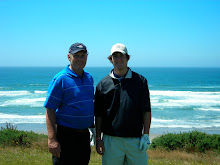
"Variety is not only the 'spice of life' but it is the very foundation of golfing architecture." --
Charles Blair Macdonald
Old Macdonald, the fourth course at Bandon Dunes, pays tribute to Charles Blair Macdonald, who was not only present at the creation of American golf but was a leading actor in the story. In 1895, he won the first Amateur Championship sanctioned by the United States Golf Association -- at the time a brand new organization that he had helped to found. He laid out the first 18-hole golf course in the country, and he poured his enormous energy and talent into the creation on the National Golf Links, on Long Island. His declared purpose was to build a "classical golf course in America, one which would eventually compare favorably with the championship links abroad and serve as an incentive to the elevation of the game in America."
Charlie Macdonald had a big ego, a big vision, and a big talent. He went abroad to study and map what he considered ideal holes, and after locating an ideal site adjacent to Shinnecock Hills (after failing in his effort to purchase that club), he built his version of those holes, adapting, combining, rearranging, and sometimes inventing features to suit his purpose. When the course opened for limited play in 1910, it was immediately recognized as one of the best courses anywhere -- a course that was as grand as Macdonald had promised.
And the National did spark the development of golf course design in America; it marked the beginning of what we now think of as the Golden Age. As the decades passed, Macdonald's reputation lagged behind while other architects, like Donald Ross and A. W. Tillinghast, were rediscovered and lionized. The explanation seems simple enough -- Macdonald built fewer courses than they did, and some of his finest courses, notably the Lido, have vanished (I'll talk about the Lido in my next post -- meantime, try to imagine the reputation of Donald Ross if Pinehurst No. 2 had disappeared). Further, his courses were ultra-private and didn't regularly host high-profile events. (The only Macdonald course open to the public is the Old White course at the Greenbrier, recently renovated by architect Lester George and slated to host a PGA Tour event, The Greenbrier Classic).
 In the last ten years, though, there's been a revival of interest in Macdonald. George Bahto's book, The Evangelist of Golf, is a feast for golf architecture junkies -- and for anyone who likes a bushy golf tale.
In the last ten years, though, there's been a revival of interest in Macdonald. George Bahto's book, The Evangelist of Golf, is a feast for golf architecture junkies -- and for anyone who likes a bushy golf tale. George, by the way, was one of the design consultants for Old Macdonald . . . more on that later. Macdonald was inducted into the World Golf Hall of Fame in 2007, and a brief version of his career is available on that site.
I've had a chance to play several Macdonald courses, and I have indelible memories of my first visit to the National. Around the second hole, Sahara, where the blind tee shot has to be played over a huge sandy waste, I felt my face stretching into a big grin, and the grin remained long after the round. The National may be getting on in years, but it's still more fun than just about any course on the planet.





No comments:
Post a Comment